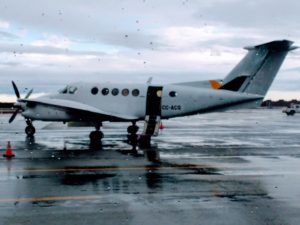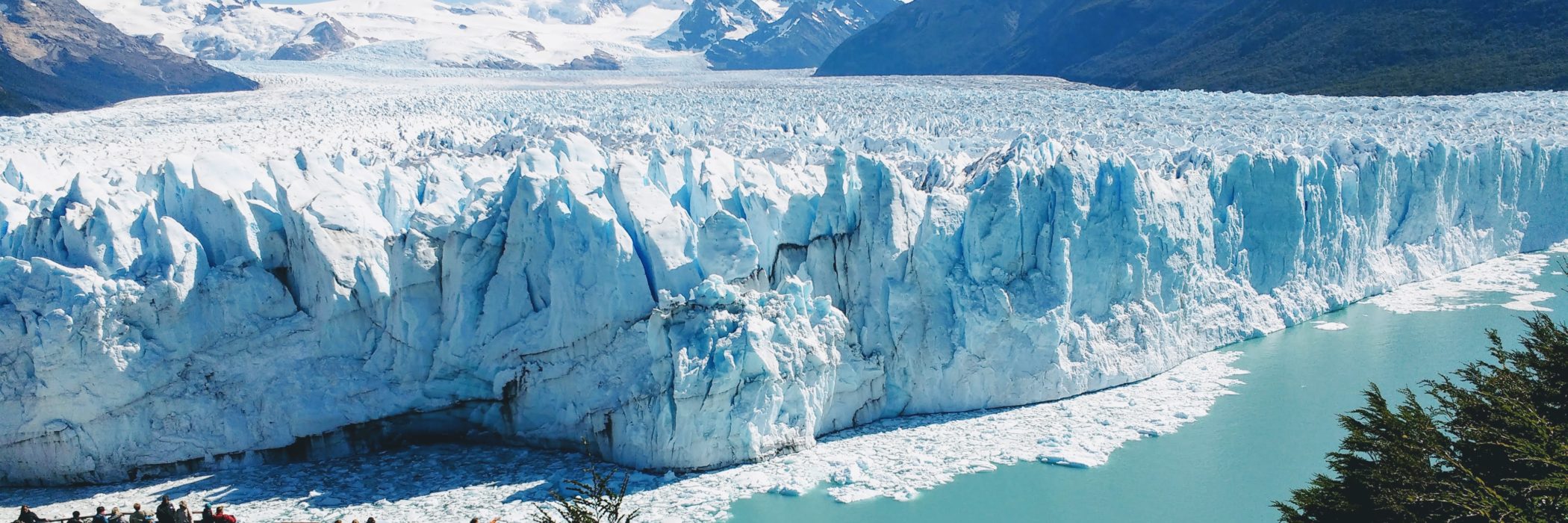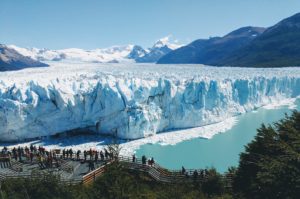Hiking in Argentinian Patagonia

Sometimes I worry that I’ve dreamed of a place so long, it won’t live up to my expectations. This was not the case with Patagonia. I’d wanted to go for years, and luckily this time my husband was able to travel with me. We’d spend three weeks starting in Buenos Aires, Argentina and ending in Santiago, Chile. I knew when we started this wouldn’t be nearly enough time, but nine days would at least give us a taste for all Argentina had to offer. And by taste, I mean, bring the wine and keep it coming!
We touched down in Buenos Aires, for a short overnight before hopping another flight to El Calafate and then a bus to El Chaltén. Our trip would follow a ‘V’ pattern due to the limited flight locations in the Patagonia region. Also because I wanted to spend less time on buses and we didn’t rent a car. After nine hours flying to Buenos Aires, we dropped our bags at the hotel, got a map and went to exchange money. This was our only goal while in BA, because I’d read that changing cash in El Chaltén was hit or miss.
We spent a beautifully warm day walking around eating empanadas, but we were eager to get south. We caught our flight early the next morning out of the domestic airport. It only took 15 minutes to get from our hotel to the gate – the small airport was easy 
to check into, and has a cafe. Our three hour flight put us outside the town of El Calafate. We had pre-booked a shuttle to the quiet hiker’s paradise in El Chaltén. Once there, we finally checked into our hosteria where we’d stay for the next five days.
El Chaltén, Argentina’s trekking capital, can be walked end to end in 15 minutes. We heard many accents and languages, even a hiker couple fighting in English which was neither of their first language. There are restaurants, bars, a couple grocery stores, laundry facilities, a bus stop and not much else. The ranger station provides free trail maps of Los Glacieres National Park, which makes up a portion of Patagonia, and we planned to do day hikes each day. The routes lasted anywhere from one hour to five days and all the trails can be accessed directly from town.


The trails are easily marked and well established, we never worried about getting lost. There are also large maps at the main
trailheads, and even rangers there answering questions and reminding hikers of trail etiquette and keeping the park clean. A few primitive bathrooms were also available. I was very impressed with not only the trails but the views – WOW! The views of the Fitz Roy mountain and surrounding peaks and green lagunas were worth the hikes. The week offered mostly clear, sunny skies but a lot of wind, for that area mother nature was at her tip top best. Although we went in high season, we never felt like the trails were crowded. We’d see lots of people at the major viewpoints, but often we’d be walking alone, which was perfect. A few days in we decided to go for a sunrise hike near town. I heard you could see the sun hit the mountains spectacularly, and it was just that. It was a short, very quiet 45 minute hike to Los Condores, and we weren’t even the first ones. A handful of other tourists had arrived before us.
Hiking in the Patagonia region reminded me of what I enjoy about hiking – the scenery, the challenge, but mostly the peacefulness. Each evening after hiking, we’d have a big dinner and a bottle of wine, and it was very rejuvenating. It was also really hard to leave. I’d felt like I spent so much time researching this trip, but being there it was really quite easy. Even if I was a solo female hiker, I would have felt very safe. But we were really excited to get back to El Calafate.

You know you are in a backpacker’s paradise when the city park bench looks like a giant pack.
We took a bus back to El Calafate and we had the afternoon to explore, and while it was defiantly livelier than El Chaltén, we were still able to walk almost everywhere. Almost everywhere – we heard about a Glacier Museum with an ice bar that sounded fun. So, we found their free shuttle bus that took us the three miles to the museum. I can’t say how the museum is, but the Glacio Bar was a blast! The museum itself is in a beautiful building, and the bar is in the basement. We paid the $10USD per person, and got a 25 minute all you can drink, “this is what it must feel like inside a freezer” experience. After donning the provided capes and kitchen mittens, our group entered the tiny room. The few tables, chairs, bar and glasses were all made of ice, and the club lights and Justin Bieber music had me drinking and dancing just to stay warm! It took about five minutes before I was cold (I’m from Texas after all), but my husband said that’s what the straight vodka was for! It was hilarious, and absolutely worth it to take the unexpected detour – as it usually is.

The next day we visited the Perito Moreno Glacier to do ice trekking with Heilo y Aventura. They are the only company that offer glacier trekking, and it was definitely a highlight. It’s much cheaper to take the local bus, but we really wanted to wear crampons and hike on a glacier. If you can spend the money, I’d highly recommend this excursion. The tour includes a boat ride across the lake, where you get your first glimpse of the glacier’s magnitude. The most interesting thing about it is that it’s advancing and not receding like most glaciers. We got a trekking tour on the glacier, had lunch and took the boat back across the lake. Once across that lake, we took the bus to the main park where the viewing boardwalks are packed with spectators waiting for the ice to calve. And when it did, it was an amazing site! But after trying to get a good view around so many people, we were even happier we took the tour because it felt more private.

We were headed to Chile early the next day, so we had one last dinner of lamb and wine. It wasn’t hard to travel around by buses and that’s how most people got around. But we were limited to the days the buses crossed the border. I had only really planned one thing for this trip and that was a day in Antarctica, so no matter what else we did I had to be in Chile on a specific day. Unfortunately, that was a day there was not a bus from Argentina to Chile.
After some searching, I emailed a couple different companies to see if they had private shuttles that would leave early enough to get us across the border to Puerto Natales. Once there we’d catch another bus to Punta Arenas, Chile. Emails were sent, and payments were made via PayPal, so I wasn’t super confident this was legit. But after the whole trip, all the pre-booked transportation I made was on time and exactly as described. So, a large charter bus showed up at our hotel bright and early with many other travelers in the same situation. The border crossing was quick and easy to get our passports stamped leaving Argentina. We stopped again five minutes later at the Chile border. It was also easy but remember to not take any fruit or nuts with you! They made me throw away a banana and an apple, even after I asked if I could just eat it right then – that was my breakfast after all.
There are many parks that make up Patagonia, and after being there I’m eager to explore more of them. All in all Argentina had been everything I hoped, but now on to Chile!
Tips:
- Change dollars to Argentinian Pesos in a big city before traveling south to Patagonia. There’s only one ATM in El Chalten,
 which apparently runs out of cash, plus many places don’t take credit cards.
which apparently runs out of cash, plus many places don’t take credit cards. - The WIFI is slow, and I didn’t see one TV in town, including in our hotel (just in case you were hoping to watch the Olympics).
- The daylight hours are long in summer.
- Many hotels have lunchbox (“viandas”) options, that are prepared and ready for you the morning of your hike, costing about $10-15USD.
- If you cross the border, check for items not allowed to avoid throwing away food. Food is not cheap there.
Antarctica: Hazardous journey, safe return doubtful
Even though venturing to Antarctica is now much easier than Ernest Shackleton’s mythical ad, I was still nervous. Getting to Antarctica these days is a lot like double dutch, it’s all about timing.
Getting there
There are two ways to get to Antarctica from Chile – by cruise ship or plane. Both are weather dependent and both cost a lot of money, but they vary in time. I didn’t have 10 days or $10, 000, so I opted for a one-day flight excursion. This still costs LOTS of money, but for me, the once in a lifetime opportunity was definitely worth every penny. DAP Airlines was the only company I could find that does one-day and over-night trips to Antartica, so there’s no shopping around or hoping the flight price will decrease.

Flying into Antarctica
I contacted DAP via email about four months before my trip, and only one seat was available for my date. They only allow six people per trip, and have about one trip a week during summer. Communication was hit or miss – sometimes they responded quickly and other times I waited weeks for a response. So if you are a planner, like me, be prepared for some stress.
Although they sent me an information packet, I still had questions. Since Antarctica would be in the middle of a three week trip, I wanted exact details, and Antarctica isn’t about that. I especially wanted to know at which hotel were we staying since I wasn’t sure if I’d have wifi while traveling. Fortunately, after all my emails they sent me the hotel information before I left so I could plan how to get there.
I was to show up in Punta Arenas, Chile the day before our trip for a mandatory meeting. All travelers have to attend a presentation on general safety, and the political treaty that countries agree to to protect this pristine frontier. A Russian couple, that spoke almost no English, and American sisters would journey with me. I was then given the boots I needed to wear for this adventure. We were told the pilots would check the weather reports, which are relayed every two hours, and decide what time we could depart.
This is where it got tricky, and why I hadn’t gotten my hopes up too much. While we planned to go on a Friday, they 
suggested another two optional days in case the weather prevented our first or second attempt. So, four nights hotel stay is included in the package, if you want to or can stay that long. If we flew out that Friday, I wouldn’t stay the other days and had planned to hike, but we did not fly out that Friday and I did not hike.
We received word that the following day’s weatherwould not be suitable for our trip. I actually breathed a little sign of relief from nervousness and slept well. At 7am the next morning, I was jolted awake by the telephone ringing and told we would leave at 8:30am! Since we had just arrived the previous evening, I hadn’t charged my GoPro, or have my clothes unpacked. This however turned out to be a blessing. I wouldn’t have slept a wink due to excitement, and general concern about traveling in a tiny plane. As I sat at breakfast too nervous to eat, I got an email saying the weather had changed for the worse, and we would be notified after the next weather report. The next report confirmed we would not be flying that day, but the weather in Punta Arenas was great, so they arranged other activities for us.

Our taxi
That night we were given a pick up time for the next morning, which was great news to have an early confirmation, and now I would be ready. The next morning however our pickup time was postponed an hour. I was starting to see where this was going. When we arrived at the airport, we were told to wait for the next weather report in an hour, if it was good we would leave immediately, since the weather windows change quickly. My emotional state during that hour was very precarious. I needn’t worry, because turns out we didn’t go to Antartica that day either. We were told the weather the next day looked great, but I was a bit skeptical at this point.
The sisters planned to fly home the next day, so with our fingers crossed, they changed their flights. They had only come to Southern Chile to go to Antarctica, which is a long, expensive way to come to have to turn around without ever making it to their seventh continent.
The next morning we were picked up on time, and actually went through airport security so it was already looking promising. But until we touched down, none of us would believe it. Although the tiny propeller plane was my biggest fear, the two and a half hour flight was very smooth.

Being there
One of the reasons the weather is so critical is because there’s no radar or airport. The pilots land on a gravel runway that they have to be able to see. In our boots, we stepped off the plane into a bucket of disinfecting solution and then onto an active runway. But by active, I mean they weren’t expecting anyone. We would spend the next five and a half hours in awe.
The day was really perfect, it was almost 40 degrees and the first sunny day they’d had in three weeks. Although we didn’t encounter many people, 10 countries have research stations there. We briefly stopped in the Russian station and Chilean station, where they stamped our passports. Our English speaking guide who told us about the plants and animals, the research being done and the history. He lived there November to March, but come winter there’d only be a skeleton crew since the conditions were brutal. Antarctica is a desert, where fire is a major concern – even the fire station burned down. It’s the coldest, windiest, driest continent with the highest average elevation and it’s beautiful. It’s quiet and has the cleanest air you’ve ever breathed.

After donning our wind suits, we hopped on a zodiac to cross the bay to see the spectacular Collins Glacier. But I was most excited when we landed on a beach full of Adelie penguins. I could have stayed the whole day on that beach. It was really special with only five people, and while we couldn’t touch the penguins some were not afraid to peck us. They were entertaining and funny; fighting, talking and chasing each other. I was bummed to leave, but then we headed to another beach with giant elephant seals, aggressive sea lions and (my favorite) chin strap penguins! We hit all the highlights in our short time, even the Russian Orthodox Church, that’s staffed by a priest year-round. The church’s construction was tested in Siberia and only uses pine and chains to hold it up.
Although we spent more time getting to Antarctica than actually being there, setting foot on the white continent was worth every worry. Seven continents done, now time to double back.
Tips:

- Start early and stay late. By that I mean book as soon as possible, prepare to be flexible and plan to stay for extra bad weather days.
- Have all your cameras and electronics charged and ready to go at a moment’s notice.





